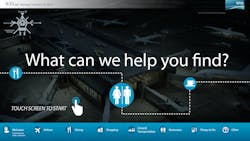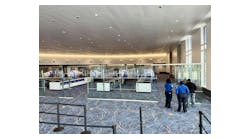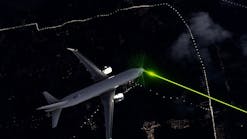Enhance passenger travel experience with digital communications and help travelers get where they need to go safely, efficiently, and effectively. Arming your passengers with the right information, at the right time, can ensure a positive experience in an environment that demands real-time sensitive information – all while improving operations by reducing the workload on your employees.
Digital communications can:
- Alleviate perceived wait times – Provide real-time updates on news, weather and entertainment to occupy travelers while they wait.
- Improve facility navigation – Help passengers easily navigate large terminals with interactive wayfinding kiosks.
- Enhance travel experiences – Provide real-time location based information such as arrival/departure times, cancellations, delays or service stoppages to keep travelers informed and reduce stress.
- Increase safety - Keep passengers safe by connecting emergency notifications and alarm systems to your digital communications platform and enable them to interrupt regularly scheduled content.
- Improve operations - Reduce the workload of employees by making real-time information available at the fingertips of passengers.
Digital communications within airports can take many different shapes and forms from arrival and departure screens, to interactive wayfinding, to menu boards, to real-time flight updates on mobile phones. Below are best practice examples from John Glenn Columbus Airport and San Francisco International Airport of how they have deployed digital communications.
John Glenn Columbus International Airport
Centrally located in Ohio with a diverse mix of air carriers, John Glenn Columbus International Airport is the airport of choice for millions of passengers each year. The airport is operated by the Columbus Regional Airport Authority, which also oversees the operation of cargo-dedicated Rickenbacker International Airport, and general aviation airport Bolton Field. John Glenn Columbus International Airport offers about 150 daily departures to 32 destinations and serves over 6 million passengers each year.
Scope
John Glenn Columbus International Airport launched an $80 Million renovation in 2013. As part of the project, the airport wanted to expand their digital signage network to improve passenger communications and experience. Included in the project was the addition of more videowalls, as well as signage over the ticket counters to provide airlines the flexibility to direct customers to particular counters for check in priority and baggage management. The airport had many plans and ideas from the architects and designers, but needed the help of a partner like Radiant Technology to determine the software and hardware required to turn the vision into a reality. While hardware was important, the airport recognized software was critical, and wanted a single platform to manage their visual communications throughout the airport.
Solution
John Glenn Columbus International Airport initially started using a digital communications solution, like Omnivex, in 2014 for a few screens in their food court. They later expanded their installation to include a large 48 screen videowall over the entrance to Terminal B which improved the resolution of the wall by 4 times. The project progressed to include another videowall in the food court which advertised the various food service vendors for travelers passing by. In March 2016, with the help of Radiant Technology, the John Glenn Columbus International Airport expanded their digital signage network even further to include two 44 x 14 foot LED videowalls over the entries to Terminals A & C, and 62 ticket counter screens in the renovated airport. The two videowalls are comprised of single, ultra-high definition, direct view LED screens driven by dedicated PCs, providing an outstanding graphics capability way beyond what the airport had previously deployed. The solution allows the displays to be driven pixel-to-pixel, ensuring crisp text and images. Each videowall features a mixture of real-time flight information, as well as advertisements and other important community messaging, and important information for travelers.
The 62 ticket counter screens were designed to be easily updated with a simple touchscreen, graphical interface. With the interactive, graphical content, airline employees have the ability to quickly login and easily alter the configuration of their ticket counter displays.
Results
The feedback on the digital signage throughout the airport has been very positive. In particular, the two large 44 x 14 foot video walls have made information very clear and easy to see throughout the ticket lobby, which has improved the experience for travelers passing through the airport. The airport anticipates the satisfaction scores on their quarterly traveler feedback surveys to increase as a result of the new screens and content.
Advertising revenues have also increased by over 50% with the new videowalls, and the outstanding quality of visuals they are able to present.
Future plans include integrating information on checkpoint wait-times and social media content from the airports social channels with the other content on the screens.
San Francisco International Airport (SFO)
San Francisco International Airport (SFO) is a world-class airport servicing more than 45 million domestic and international passengers annually. The airport is one of the largest in the United States and features 4 terminals with 7 boarding areas. San Francisco International Airport (SFO) offers non-stop flights to more than 34 international cities on 29 international carriers. It is the Bay Area's largest airport and connects non-stop with 78 cities in the U.S. on 15 domestic airlines.
Scope
Given its size, navigating SFO, particularly when going from terminal to terminal, has been complex for travellers. Historically, the airport has used over 270 paper maps airport wide to help travellers get to where they need to go. These paper maps, while effective, have not been ideal. The paper maps can't be immediately updated when there is a change, and the cost of reprinting and the staff time involvement is high. In 2012, SFO launched a project to renovate Boarding Area E. As a part of this project, SFO implemented an interactive wayfinding system in this newly renovated area that would eliminate the need for paper maps, assist in navigating from terminal to terminal, and provide travellers with the best route to get where they need to go.
Solution
San Francisco International Airport (SFO) had been using digital communications, such as Omnivex, for a number of years. With the renovation of Boarding Area E in Terminal 3, SFO decided to take the opportunity to start migrating the airport to an interactive wayfinding solution. Boarding Area E opened in January 2014 with two interactive wayfinding screens in the remodelled boarding area. The screens enable travellers to easily find where they need to go anywhere in the airport and the best route to get there, whether by walking or by taking the airport's automated AirTrain. They also allow passengers to explore their options for dining, shopping, and things to do, giving them a more rewarding airport experience. The touchscreens are location-smart and thereby predetermine appropriate destinations based on the passenger’s pre- or post-security location.
The interactive wayfinding solution enables SFO to tie data in from various source systems (maintenance, elevators, emergency alarms, etc.) and devices (RFID, barcode scanners, etc.), to the interactive maps & floor plans so what users are seeing reflects the current environment in the facility and takes into consideration things such as construction closures or other things that might impact a particular route. As well through the use of conditional formatting, it factors information like elevator operation times and route lighting when determining the best route for getting from point A to B at a particular time of day. By interfacing with a variety of source systems, the solution can also handle multi-floor and multi-region wayfinding, thus providing users with maps covering multiple areas, such as buildings or terminals, and multiple transfer points such as stairs, elevators, tunnels or bridges. The connections into real-time data and devices also ensure that the system is kept current and there is no need for reprinting maps or replacing signs each time something changes.
During the initial deployment, SFO surveyed users of the interactive wayfinding screens to see what they liked about the new system and what they were using it for. Plans are already in place to add more interactive wayfinding screens across the airport and to add more features. Content, user experience, and user interface design was developed by Ilium Associates.
Results
With the deployment of the interactive wayfinding screens in the newly renovated Boarding Area E, SFO has been able to enhance the experience of the travellers passing through the airport each day. This digital approach to providing directions and maps will also help reduce costs such as map printing and labor.
It is apparent digital communication can be used to drastically improve traveler experience, as evidenced through the examples from John Glenn Columbus Airport and San Francisco International Airport. Improving facility navigation, alleviating perceived wait times, improving operations and increasing safety are just a few of the ways in which these airports have used digital communication within their organization. The possibilities are endless, and in today’s digital era, customers have come to expect their experience to be improved by technology, it is no longer just a bonus. Customers expect information to be where they need it, when they need it. This is especially important in large venues such as airports, where emotions run high for some, and anything from finding the correct terminal, to finding delay information can be frustrating and stressful if not presented properly. These organizations have seen an immense value add by deploying digital communications throughout their facilities, and will continue to implement more solutions to maintain their competitive advantage.
Doug is Chief Executive Officer and Chief Technology Officer of Omnivex Corporation. He is considered by many as a visionary in the digital communications space. In his role as CEO and CTO Doug is responsible for the long term product architecture and the overall vision for the company.




